|
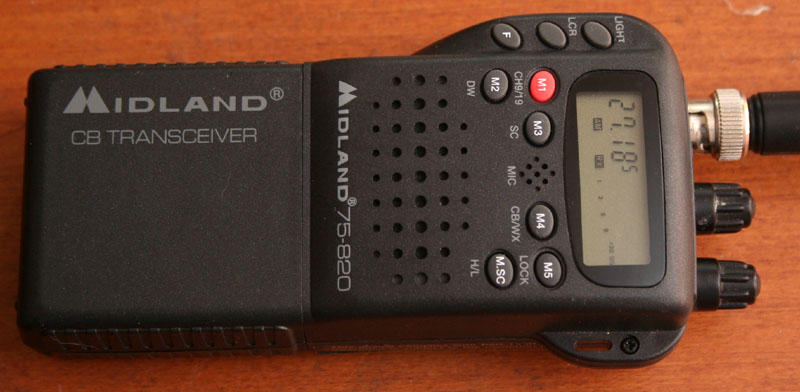
Midland 75-820 (822)
This is essentially the
same radio, made to the same design, and produced by the same company, as the
old Cherokee AH-27 - almost. The Midland has a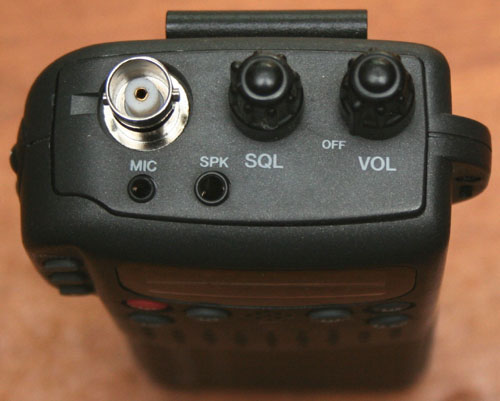 few new features, and is a
bit more well adapted to CB than the AH-27, which is a reworked ham radio. This
is one of a new breed of high quality CB walkie talkies. They are a welcome
addition. The newer 75-822 is the same radio, made a bit more difficult to
modify, per FCC regulations. few new features, and is a
bit more well adapted to CB than the AH-27, which is a reworked ham radio. This
is one of a new breed of high quality CB walkie talkies. They are a welcome
addition. The newer 75-822 is the same radio, made a bit more difficult to
modify, per FCC regulations.
As a boy, I had a number
of walkie talkies, as did many of my friends. These were the small 100 mw units,
with extensible antennas, and a range of perhaps a block or two (the packaging
claimed a range of a quarter mile). Despite their limitations, these were prized
possessions, and inspired a number of baby boomers to become CB enthusiasts and
ham radios operators in latter life.
Better walkie talkies were available, but
were expensive, heavy, and required a license. As the baby boomers grew, the CB
craze flowered, and millions of units were turned out, cost cutting measures and
economies were taken, and some pretty poor quality radios started to be churned
out. This was particularly true after the end of the craze, sometime in the
eighties. It was almost as if the shoddy little radios of our childhood were
returning.
Even with the cost cutting efforts, it was
sometimes possible to find a good quality walkie talkie. Though most of the
distributers of CB radios did not take the limited walkie talkie market very
seriously, Cobra and radio Shack had a few decent models out. With the end of
the CB craze, the market became, as it was in the sixties and early seventies,
smaller but somewhat more dedicated. Such a market was a bit more quality
conscious than the previous mass market.
 With a return to a more discriminating market, came some higher quality radios.
Among them were some new Cobra's, the marvelous Cherokees, and some high quality
radios by
Midland. This particular unit is
produced in Thailand,
though it takes many of the same accessories as the Korean produced Maycom
radios sold by Radio Shack, Cherokee, and others. The basic layout is similar to
these other radios, though it does differ internally, and does not use the same
boards and components.
With a return to a more discriminating market, came some higher quality radios.
Among them were some new Cobra's, the marvelous Cherokees, and some high quality
radios by
Midland. This particular unit is
produced in Thailand,
though it takes many of the same accessories as the Korean produced Maycom
radios sold by Radio Shack, Cherokee, and others. The basic layout is similar to
these other radios, though it does differ internally, and does not use the same
boards and components.
The radio
itself is built to a high level of quality, is reasonably well weatherized, and
has a number of power options, as well as antenna options. In addition to being
able to operate on all forty CB channels, this radio can receive weather
broadcasts, and is also amenable to mods permitting use of European frequencies
and outbanding. There is a provision on the unit for an external speaker and
microphone, as well as a standard BNC connector for attaching a better antenna.
The top of the radio has these connectors, as well as the volume and squelch
controls.
The side of the
unit has the PTT switch, as well as the buttons to step through the channels.
These controls are all sealed and weatherproofed. This is also where the latch
is located for the battery pack. In common with the Maycom/Cherokee series of
radios, these controls are on the side of a blister extending off of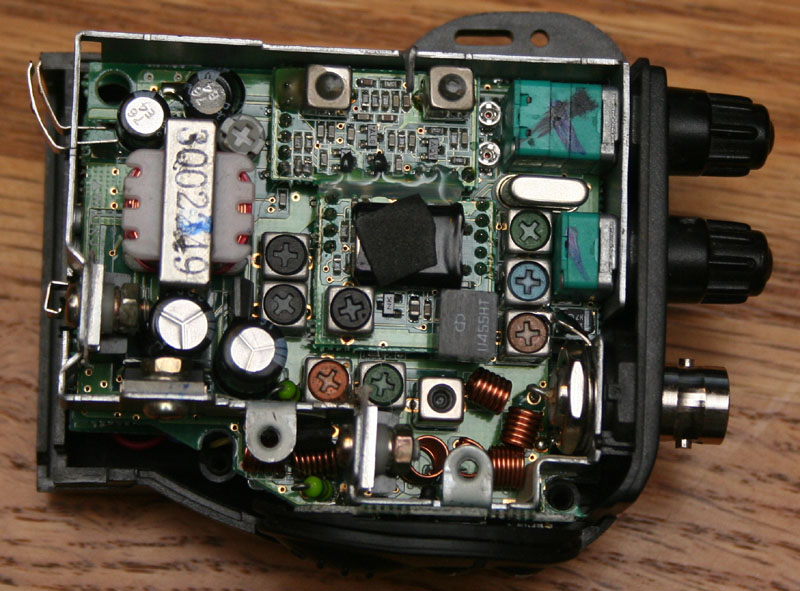 the side of the radio body. This blister also has buttons to control the display
light, as well as buttons for last channel recall and the function switch.
the side of the radio body. This blister also has buttons to control the display
light, as well as buttons for last channel recall and the function switch.
Most of the other controls are
on the front face of the unit, under the LCD display. These include the channel
memory buttons, the high/low power switch, and the scanning button for scanning
the entire band, or the five memory channels. There are also buttons to access
the ten weather channels, lock the keyboard, and give immediate access to
channels nine or nineteen. Everything is nicely laid out, well sealed, and of
good quality. These radios will last a long time. Build quality is good inside
and out, as I discovered when I disassembled the unit to tighten the antenna
connector. I have included a photo to the right. Though no mods can be made from
this side, it is nice to know that this is not a throwaway radio, and can
actually be repaired.
The front mounted LCD display
indicates channel or frequency (Selection can be made between the two by holding
the "F" key for about two seconds). It also has a multi segment S/RF display as
well as indicators for battery life, TX/RX, mode, watch, power level, scan, and
priority channel.
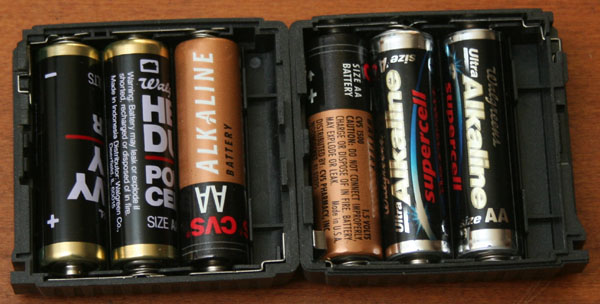 Even with five watts on tap, the standard rubber duck antenna only gives a range
between units of a mile or two. This might be extended to five miles or so when
communicating with a mobile, and perhaps ten or twenty when talking to a base.
The standard BNC connectors do accept a number of longer range more efficient
antennas, though you then begin to run into problems with the unit becoming
cumbersome. At the battery saving one watt setting, range would be a bit less.
Even with five watts on tap, the standard rubber duck antenna only gives a range
between units of a mile or two. This might be extended to five miles or so when
communicating with a mobile, and perhaps ten or twenty when talking to a base.
The standard BNC connectors do accept a number of longer range more efficient
antennas, though you then begin to run into problems with the unit becoming
cumbersome. At the battery saving one watt setting, range would be a bit less.
There are a number
of power options, taking the form of several different types of packs which
will slide on to the bottom of the unit. The standard included pack is the six
cell pack, designed for 1.5v alkaline batteries. Also available are eight cell
packs for rechargeable 1.2v batteries, as well as sealed nicad and NiMH packs.
All packs are designed to provide nine volts. The battery packs are fairly
universal, and this radio will take all of the Cherokee/Standard/Maycom packs.
The newer generation of high voltage rechargeable batteries (usually marketed as
precharged rechargeables) makes it possible to use the six cell pack with
rechargeable batteries and suffer no loss in voltage or transmit power.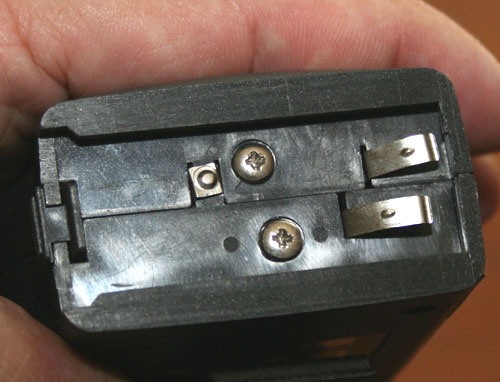
Mobile Com adapter
The ultimate power source would
be an AC power adapter, or a car adapter. Both are available. Slide on battery
eliminators are available for these radios, as well as a unique adapter known as
the mobile com. The Mobile com slides on in place of the normal battery pack,
and permits the unit to be powered off of a standard cigarette lighter.
In
addition to the power adapter, the Mobile com has an antenna adapter which
permits connection to a standard coax connector, for use of a base or mobile
antenna system. Both connectors split off of a coiled cable which feeds out of
the bottom of the adapter. This allows the unit to be used in the manner of one
of those mobiles with all of the controls in the microphone head. The bottom of
the radio, in addition to the power connectors, has a small numb that serves as an antenna connector, which
mates with that in the Mobile com unit. Connected in such a fashion, the BNC
connector is disabled. The two other screws shown in the photo to the right are
used to join the two halves of the radio case.
The Mobile com works with an
entire series of related hand held radios from various manufacturers, and is a great accessory to have, for
quick or transient connections. It presently comes standard with the nearly
identical Midland 75-822, and adds
a great amount of versatility to that radio. With the built in weather radio,
and connection to an external antenna an power source, this might be a good
choice for use in in a small boat.
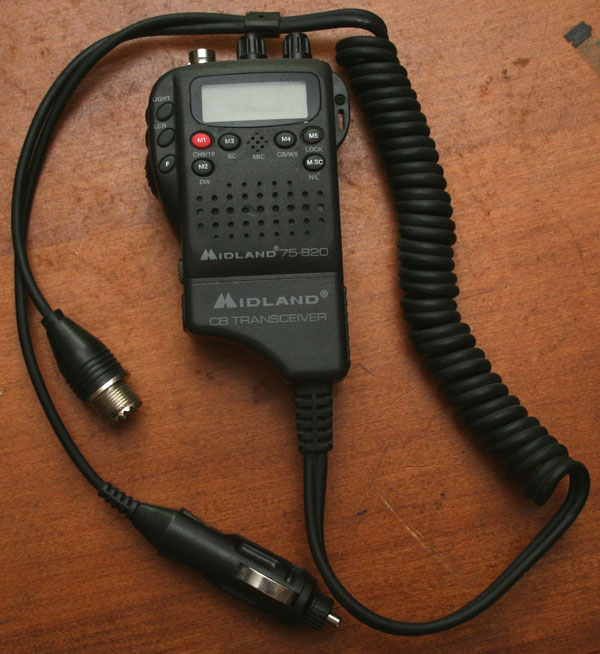 Use of the mobile com gives an
honest five to ten mile range to this radio, perhaps a bit more, and extends its
capabilities considerably. Used in mobile mode with this adapter, I get very
good reports, and no one seems able to
tell I am talking on a hand held. It is also possible, though a bit over
elaborate, to plug in an external speaker and microphone. Use of the mobile com gives an
honest five to ten mile range to this radio, perhaps a bit more, and extends its
capabilities considerably. Used in mobile mode with this adapter, I get very
good reports, and no one seems able to
tell I am talking on a hand held. It is also possible, though a bit over
elaborate, to plug in an external speaker and microphone.
With the adapter, this makes a
nice loaner radio, emergency radio, or quick install for a borrowed or rental car. it is also a
popular choice for use with a motorcycle, particularly with the external speaker
and microphone jacks permitting connection to helmet speaker and mike systems.
It is then possible to disconnect from the adapter, and store the radio, or to
slide on a battery pack and pop the rubber antenna on, and have a walkie talkie.
The adapter also makes it easy to connect to an AC power supply an dbase antenna
for home use.
Though often bundled in, the
Mobile com adapter is available for $20 - $30, as a radio accessory. As of this
writing, the current midland high grade CB (model 75-822) is available with the
Mobile com adapter included for right around $100. To my mind, it is worth the
cost, just for the adapter, particularly if there is already a hand held or two
around, that are compatible.
As a part of a range of power
accessories that fit compliant radios, I can use this adapter with my Cherokee
radios, as well as the Midland. All three of the radios show in the photo below
can use this adapter, the same power packs, and many of the same accessories,
such as the headset and speaker/microphone. Its nice to have options.
As I only have a pair of these adapters, and have something like six compatible
radios, there is sometimes a bit of swapping going on. One nice feature is that
I now always have a radio with me, due to the ease of installation. Now if
someone would only made a compatible multi band HF radio.
Specifications
Specs on this radio are pretty good for a handheld, and as good as most
mobiles these days.
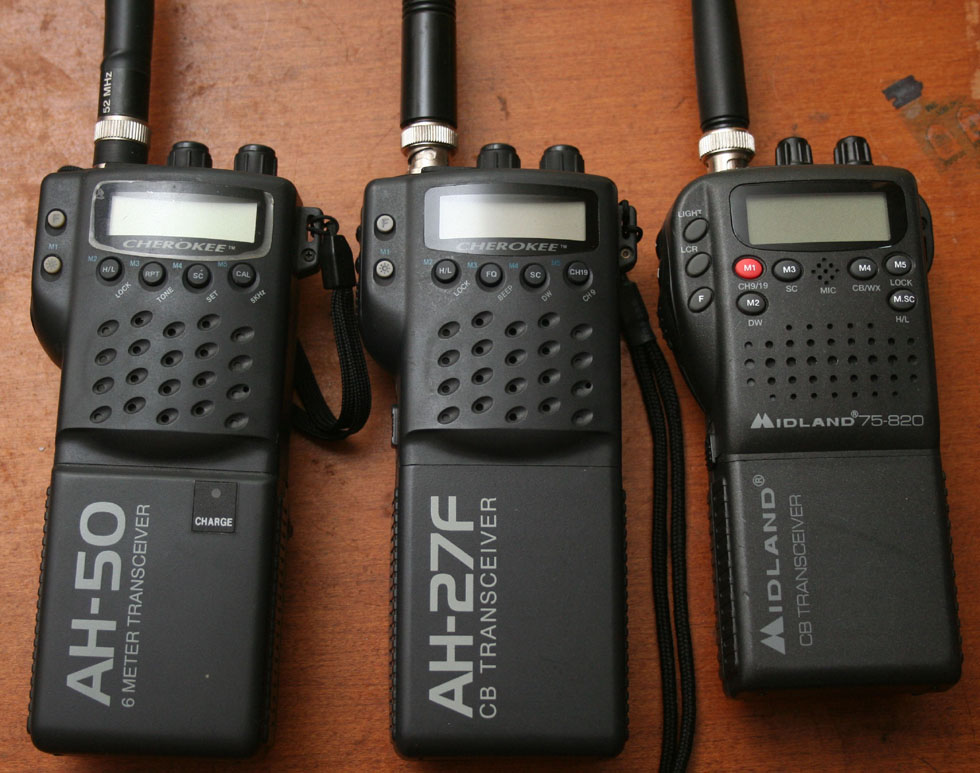
Mods
Like most modern production radios, there
are a number of modifications that can be applied to this unit. As this
radio was designed to be marketed in the United States, as well as Europe, it is
set up so that either the standard American CB frequencies can be used, or the
80 channel European band plan. It is also capable of using forty channel bands
downshifted and upshifted from the regular United States forty channel CB band,
which is the most popular mod to apply here in America. Applying this mod gives
120 channels.
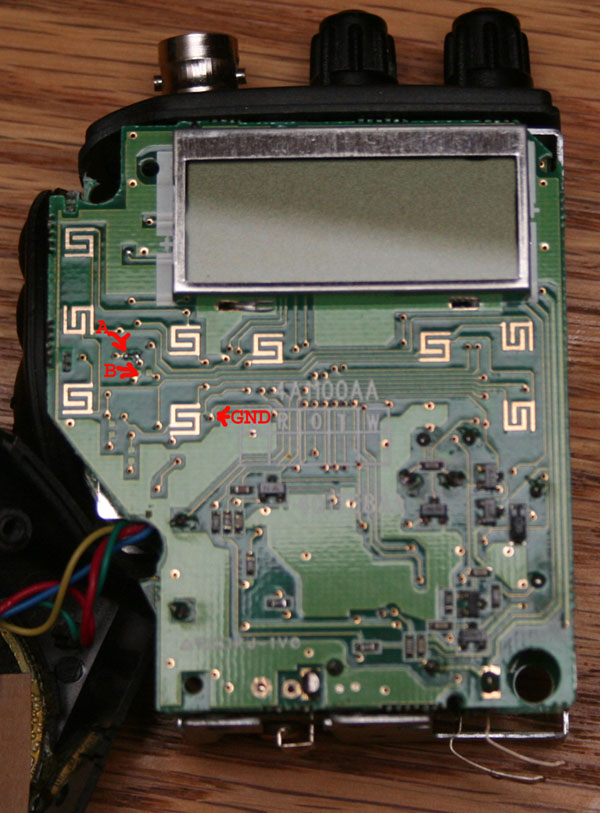 |
- Jumper only pad marked "A" for 120 channel operation. This will
provide 40 normal CB channels, plus 40 channels above and 40
channels below the standard channels. Coverage from 26.515 MHz to
27.855 MHz. The "A" channels are not covered. (i.e. 3A, 7A, 11A
etc.)
- Jumper pad marked "A" and "B" for the new European 80 channel
band plan. Channels 1 -> 3 are FM mode, Channels 4 -> 15 are AM
mode, Channels 16 -> 80 are FM mode. Note that channels above
channel 40 are lower in frequency then channel 1.
- Jumper "B" only gives the UK FM mode band plan.
- Next locate the feed through point labeled GND, this is the
point that is grounded to provide a reset to the microprocessor
- After changing any of these jumper pads it is necessary to
ground the feed through at point GND to force a reset of the
microprocessor.
|
Links
|
few new features, and is a
bit more well adapted to CB than the AH-27, which is a reworked ham radio. This
is one of a new breed of high quality CB walkie talkies. They are a welcome
addition. The newer 75-822 is the same radio, made a bit more difficult to
modify, per FCC regulations.
With a return to a more discriminating market, came some higher quality radios.
Among them were some new Cobra's, the marvelous Cherokees, and some high quality
radios by
the side of the radio body. This blister also has buttons to control the display
light, as well as buttons for last channel recall and the function switch.
Even with five watts on tap, the standard rubber duck antenna only gives a range
between units of a mile or two. This might be extended to five miles or so when
communicating with a mobile, and perhaps ten or twenty when talking to a base.
The standard BNC connectors do accept a number of longer range more efficient
antennas, though you then begin to run into problems with the unit becoming
cumbersome. At the battery saving one watt setting, range would be a bit less.
